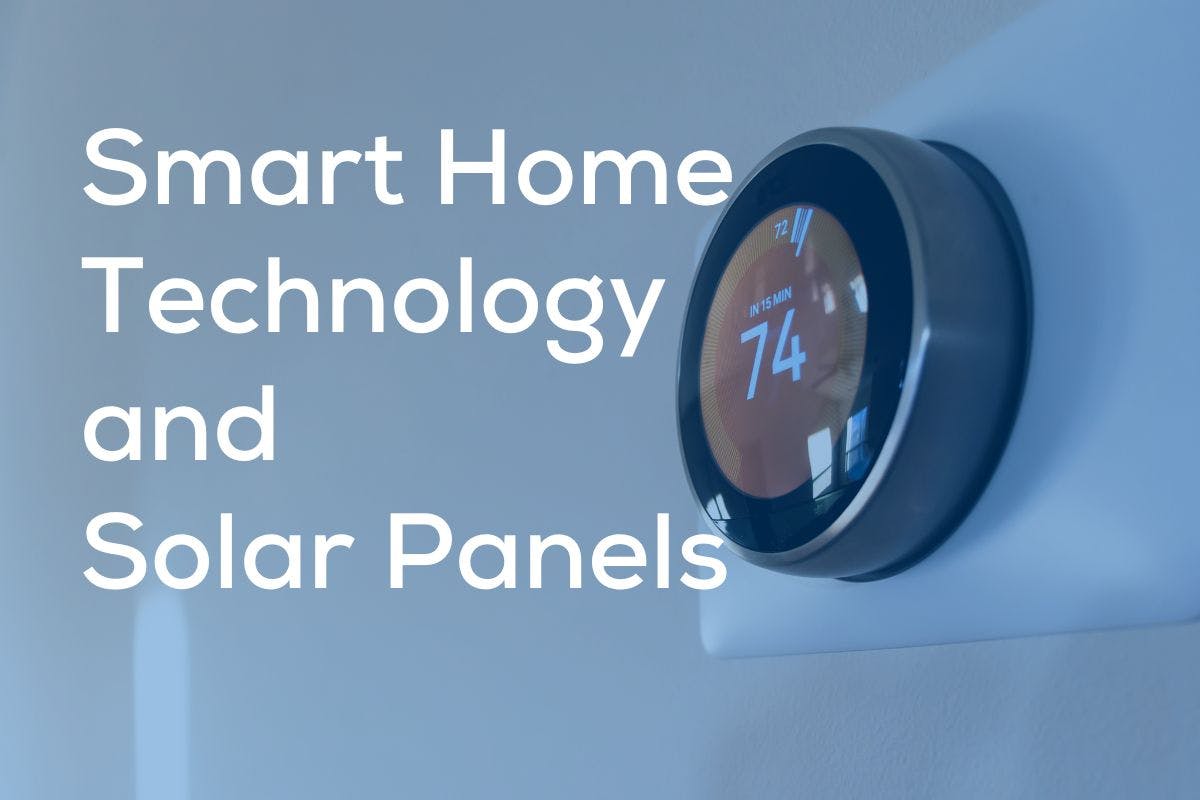Home solar panels save you money by helping you avoid and offset electricity from your utility. The more energy you save or offset through net metering credits, the more you save.
Smart home technologies — from smart thermostats to smart plugs to smart lights — can help your solar energy go farther by making your home more energy efficient and shifting energy use to when your solar panels are generating. Solar and smart devices can be a winning combination for home energy control, security, and long-term savings.
Here’s how the two technologies can work together to make every electron you use at home work even harder for you.
See how much you can save with home energy changes
What Is a Smart Home?
A smart home is any home with automated or remote-controlled appliances used for everyday life. Made up of interconnected devices, smart home systems can incorporate app-based control of a house’s lighting, heating, cooling, access, or security.
Smart home devices
As the variety of smart devices continues to grow, today’s homes are becoming increasingly sophisticated. While comprehensive smart technology can be directly incorporated in new buildings, smart home devices can also be installed one by one in existing homes.
- Smart thermostats communicate with a home’s HVAC system and connected apps to automate and schedule home heating and cooling.
- Smart access and security systems keep your property safe with digital keys, garage door openers, doorbells, cameras, and more.
- Smart plugs let you schedule and remotely control power to home devices. They can be built into the wall or added to existing power outlets.
- Other smart appliances and gadgets include speakers, vacuums, refrigerators, air conditioners, water heaters, dishwashers, laundry machines, pet feeders, and more.
Beyond energy consumption, smart home technologies like smart irrigation controllers can conserve water while leak detectors and freeze prevention systems can stop a costly disaster early.
The Benefits of Smart Home Technology
Smart appliances and devices can unlock three key benefits: energy savings, convenience, and financial incentives.
Energy savings
Smart home technology can let you schedule appliances to run when your solar panels are producing or electricity is cheapest. Scheduling your lights, washer and dryer, dishwasher, and heat pump let you do the most energy intensive tasks when you can save the most.
And no more forgetting to turn the lights off! Just schedule them to go dark when you leave for work.
Convenience
Smart devices let you “work smart, not hard,” in managing your home’s energy efficiency. While you could manually toggle lights, your AC, and other appliances around your time-of-use rates, smart systems can automate them with just a few taps of your smartphone.
Financial incentives
You may be able to enroll your smart devices in energy conservation programs that utilize their remote control capabilities. You could also qualify for other incentives. Here’s how the most common programs work.
- Demand response programs. In a demand response program companies, called aggregators, remotely adjust or switch off smart devices at times of high demand (with the device’s owner’s permission, of course), in return for some sort of compensation.
- Product rebates. Smart technology rebates are sometimes offered by the manufacturer, your utility, or your city or state. Rebate values range by provider and category, with incentives commonly ranging from $20 to $2,000 and beyond.
- Tax credits. Several smart technologies, like HVAC systems and water heaters, that meet certain efficiency standards can qualify for the nationally available Energy Efficient Home Improvement Credit. When installing a smart heat pump system, you may also qualify for an additional federal tax credit worth up to $2,000.
(Tax credits for energy efficiency are being debated in Congress in 2025 and could be modified. Confirm your eligibility and the credits availability for yourself.)
See how much you can save with home energy changes
Smart Home Costs
The total costs of smart home systems depend on their scope. You can start small with a few smart plugs (about $10 each) or a smart thermostat (under $100 to several hundred). If you’re upgrading your water heater you can spend hundreds of dollars. So while there is a large range of potential project expenses, complete smart home upgrades for temperature control, lighting, and select major appliances can cost between $2,000 and $9,000.
Common smart home devices can range in cost depending on their features and demand.
Average costs for select smart home devices
| Device | Cost |
|---|---|
| Smart Plug | $6-25 |
| Smart thermostat | $80-250 |
| Smart light bulbs | $6-10 |
| Smart locks | $120-200 |
| Smart speakers | $50-250 |
| Smart water heater | $1600-3000 |
How Smart Homes and Solar Panels Work Together
Solar systems can be installed with a smart meter, energy management system, and optional battery storage, and smart devices can make the most of the electricity they generate.
Smart meters and solar energy savings
While millions of traditional electric meters still operate in the US today, about 3 in every 4 homes have a smart meter installed. These devices enable two-way communication between your home and the electric utility.
Smart meters allow you and your energy utility to monitor the electricity you consume and share with the grid in real-time. With this, utilities can more accurately forecast grid power supplies and introduce time-of-use (TOU) rates, in which the price of electricity fluctuates with the time of day.
Smart meters come standard in nearly every new solar project and, while programs vary across the country, they can usually be leveraged to participate in demand response programs and maximize your net energy metering credits.
Home energy management systems
A home energy management system processes and controls the electricity information coming to and from your property. It may replace or connect to your electric panel and can generally be controlled online or with a mobile app.
A few essential home energy management system functions include:
- Detailed energy consumption monitoring with appliance-by-appliance usage
- Automation that uses real-time data to maximize energy efficiency or cost savings
- Easy integration with solar panels and battery storage systems
When you go solar with Palmetto, you can monitor your renewable energy production, optimize your home electricity consumption, and track your solar savings all within the Palmetto App.
Solar battery storage
No single device is poised to redefine the future of home energy quite like battery storage. By letting you store power for later, batteries let you stretch your solar savings farther. Newer batteries may work with your local utility rate to use their stored energy in a way that saves you the most money.
Across the US, many emerging utility programs compensate solar battery owners for sharing stored electricity during scheduled or spontaneous events of increased local energy demand, like the Self-Generation Incentive Program in California and New England’s ConnectedSolutions program.
By tapping into dispersed customer resources, these programs allow electric utilities to create virtual power plants without building additional energy infrastructure.
Intelligent systems allow your home to operate efficiently, and solar energy can help maximize your investment in smart home technology. By automating parts of your home and going solar, you can power your property in the greenest, cheapest, most convenient way possible.
If you are interested in how solar could help you save money on energy at home, reach out to a solar advisor today or estimate your savings with Palmetto’s solar savings estimator.
See what home electrification can do for you:
Frequently Asked Questions
Can smart home devices save me money?
Yes, smart home devices can save money through energy-efficient operation, load shifting, automatic shut-offs, and other product features. Although smart upgrades usually cost more than non-smart alternatives, efficient devices may qualify for financial incentives and lead to long-term energy savings.
What is demand response?
The International Energy Association (IEA) defines demand response programs as those that encourage “customers to shift electricity demand to times when electricity is more plentiful or other demand is lower, typically through prices or monetary incentives.” In other words, these programs allow homeowners to financially benefit when they help balance supply and demand on the grid.
How do solar panels and smart devices work together?
Smart thermostats, energy management systems, and other Internet-of-things devices can help your home use energy more efficiently when solar energy is most abundant, stretching your solar energy farther.
Disclaimer: This content is for educational purposes only. Palmetto does not provide tax, legal, or accounting advice. Please consult your own tax, legal, and accounting advisors.
 Andrew BlokWriter and Editor
Andrew BlokWriter and EditorAndrew has worked as a journalist and writer for four years, over half of those dedicated to covering solar. He currently lives in Tucson, AZ, where you might run into him walking his dog and birding while dodging the heat. He has degrees in English education and journalism.


